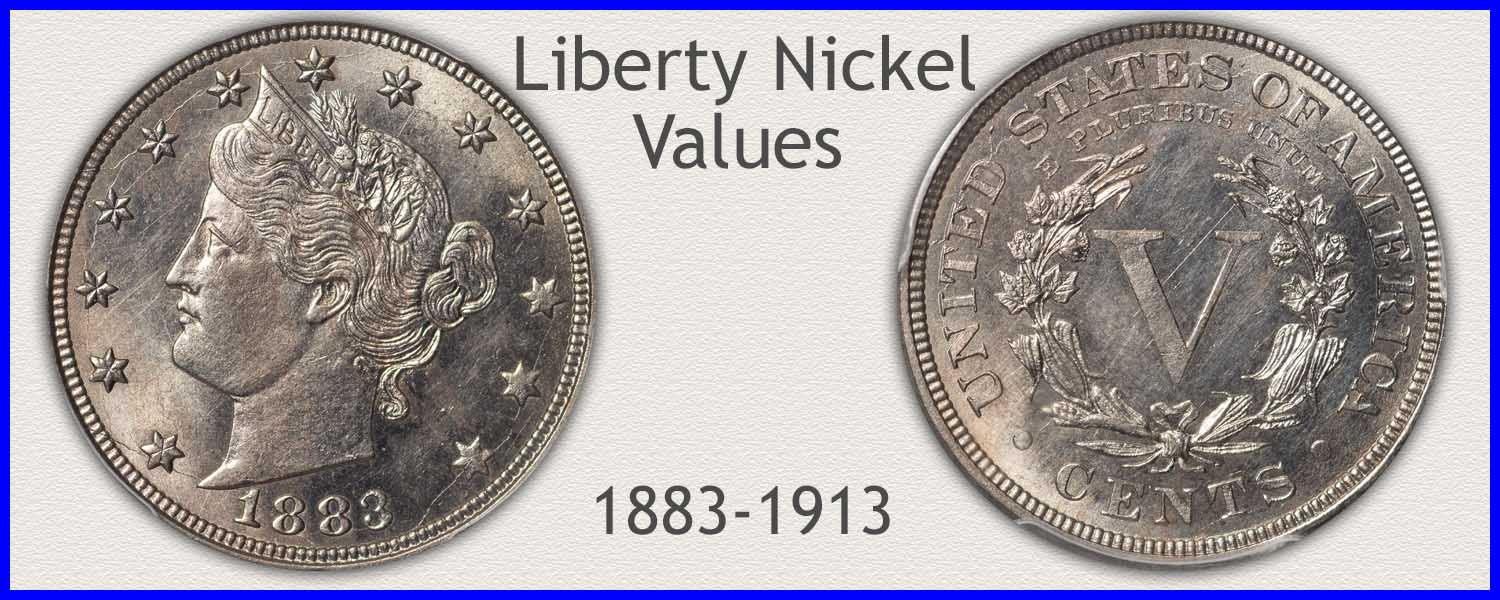Coin Values Moving with Precious Metals: Up-Dated 4/14/2025: Gold $3226 | Silver $31.88
1907 Nickel Value
High numbers produced is a major factor to 1907 nickel value. Today it requires an above average quality Liberty nickel of those minted during the latter years of the series to reach added premiums.
Although most remaining Liberty nickels are in very worn condition, grading their condition is a key to how much they are worth in the coin market. Defined steps lead through the evaluation of date, condition, and recognizing the special qualities as part of finding its place on the value chart.
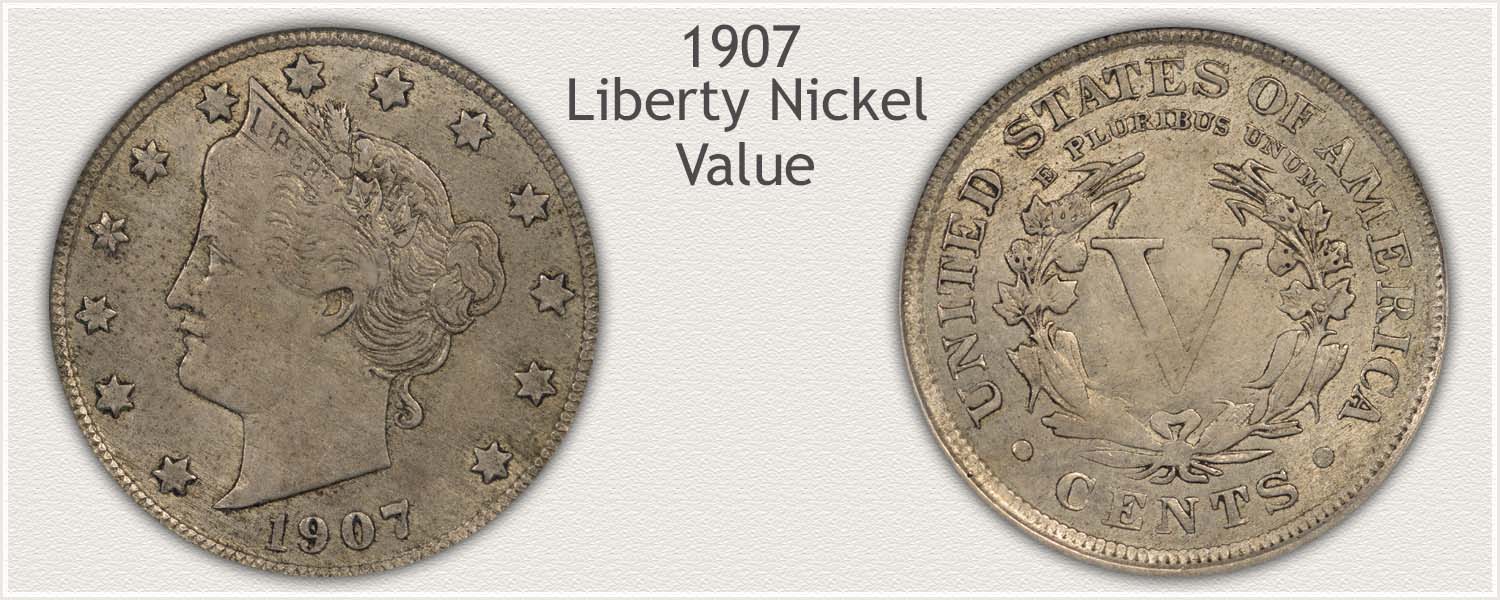
Steps Leading to Value:
- Step 1: Date Identified - A confirmation of the date is made to provide an accurate description of these old nickels.
- Step 2: Grading Condition - Here a large separation in value is determined by the condition and amount of detail remaining on the coin.
- Step 3: Special Qualities - Aesthetics is a subtle but strong influence to the appeal of collectible coins. Eye appealing examples, when recognized, strengthen their base value.
| 1907 Nickel Value | ||||
|---|---|---|---|---|
| Condition of Coin | ||||
| Date | Good | Fine | Extremely Fine |
Mint State |
| Liberty Nickel Value Updated | 2024 | |||
| 1907 | $1.32 | $3.71 | $25 | $52 |
Market values listed above are a range to the wholesale values. Use as a starting point when selling these Liberty nickels.
Step 1: | Accuracy of Date Confirmed
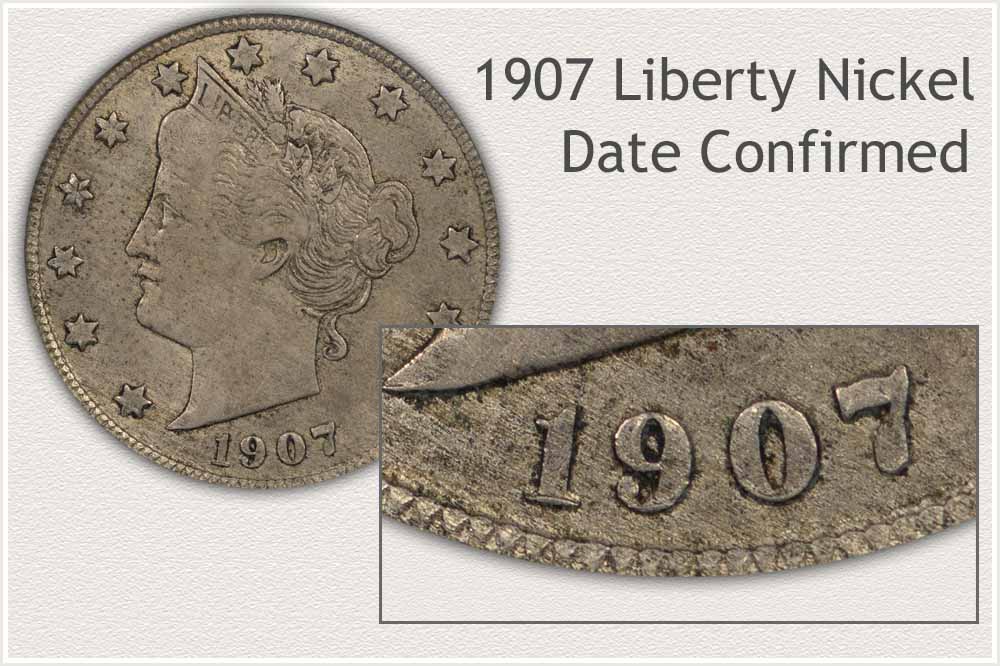
1907 nickels were all minted and the main U.S. coinage facility in Pennsylvania. In context of the entire series a huge number was released into circulation, over 39 million. This became the second highest yearly amount of the Liberty series.
The Philadelphia mint was the only mint to strike nickels, all other branch mint concentrated on silver and gold coinage. With one variety to the year a second, confirming inspection of the date is needed for accuracy. In today's market, many 1907 nickels are available. It is the quality of preservation, amount those remaining, that sets the each apart. Complete evaluation is judging condition next.
Step 2: | Grades Define Important Value Categories
High Quality is Recognized by the Coin Market as Infrequent
The objective of judging the condition of this particular year, 1907 nickel, is to recognize above average quality. Most latter year examples of the Liberty series suffer from both heavy wear and damage, lowering their appeal as a collectible.
Grading is the process of comparing a coin's condition to images of the different stages of wear, each represents a "Grade." These grades are used in the coin market as part of the description and classification of the condition. No matter the condition of the coin, begin with a review of the Mint State example. Awareness of the complete design as minted, aides in understanding the remaining detail on a worn nickel.
Mint State Grade
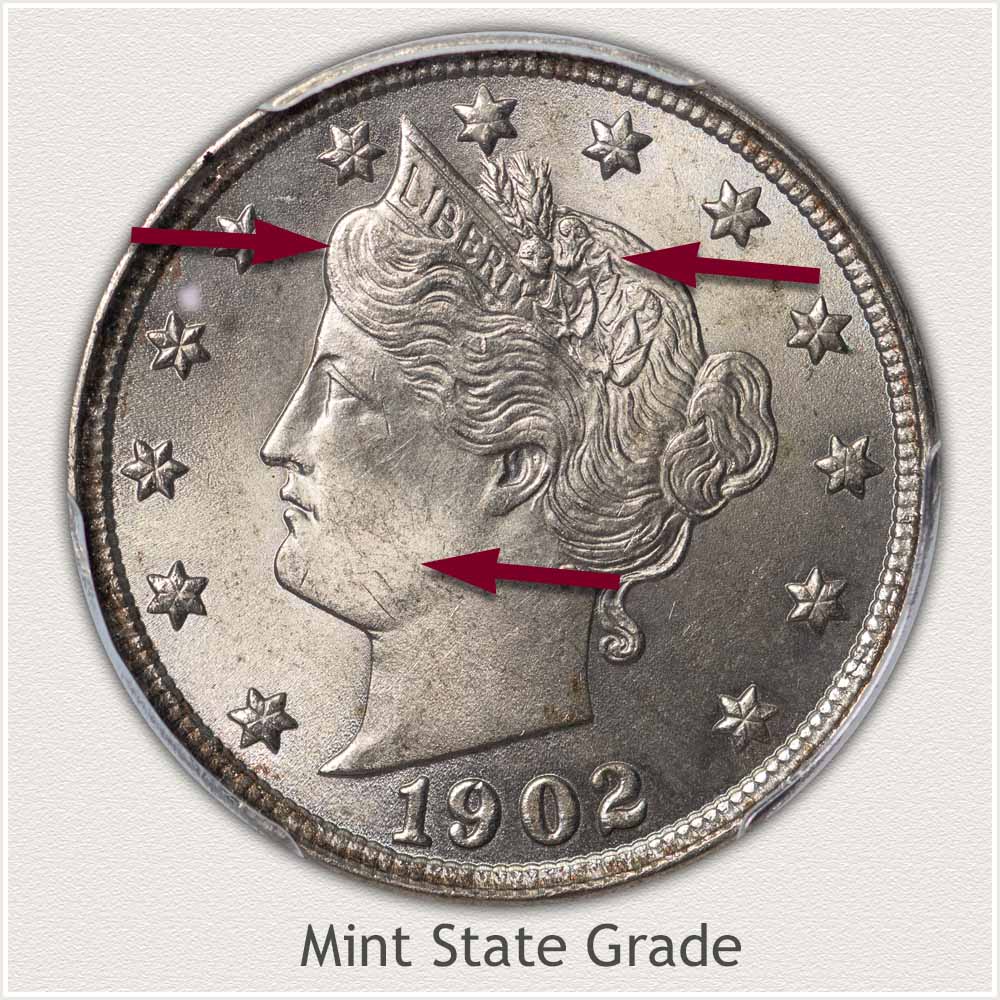
Mint State: Starting at the outside edge, to the thirteen stars framing a highly detailed portrait of Liberty, many details are inspected as part of a Mint State grade. Condition of these top-quality nickels is summarized as - no wear - to the surface.
As a coin is minted, the force of striking the metal leaves a brilliant mint luster to the surface. Completeness of the shine and texture of the luster are key indicators of the Mint State grade. Looking at Liberty's cheek, no wear is causing the metal to appear dull, it remains with the original minting texture and luster.
High points of the design are next inspected for signs of wear. A typical wear point is the hair above her brow. In the wave of hair, high contours separated by recessed lines are without signs of flattening. Wear causes smoothness to the metal. Tilt the coin to a low angle to better view any reduction to rounded contours. Check the fine edges to the leaves above the hair band, also looking for signs of smooth metal and flattened contours. A brilliance remains throughout.
Extremely Fine Grade
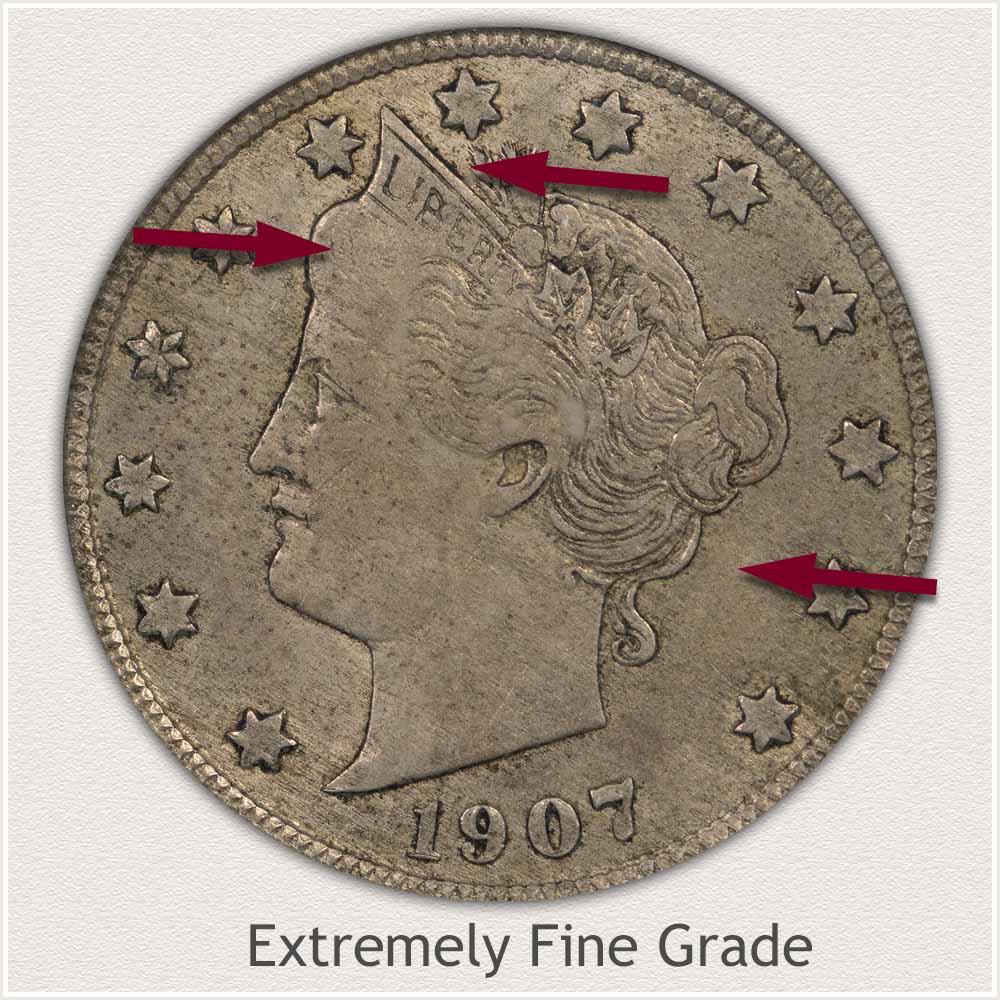
Extremely Fine: Extremely Fine is an important grade, representing a large change in value. This grade is noted as retaining many details, especially the finer lines in Liberty's hair. Indicating wear, is the visible merging of hair strands above the forehead and a slight amount of fading of detail above her ear. Maintaining the grade is each area of smooth metal is separate.
Her headband must display a complete LIBERTY with all letters full, top to bottom. Once major elements of the design, such as lettering is missing, a lower quality is indicated. A full hair line from the forehead to ear is also a strong requirement for the grade.
Although most of the texture of luster is worn, no major change in the contours of Liberty's cheek and neck area has occurred. These open areas do not show a flattened appearance.
Fine Grade
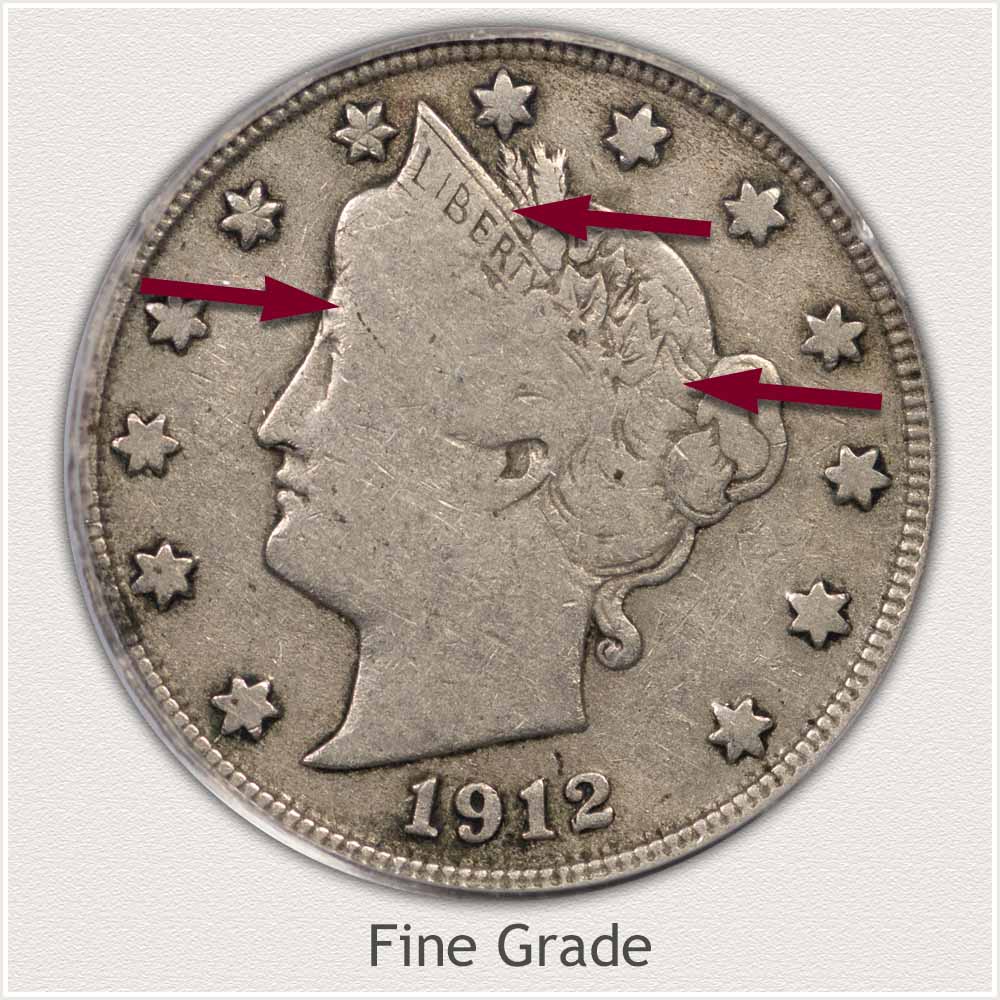
Fine Grade: Helping identify the Fine grade is the noticeable wear and merging of major details. Moderate wear is seen throughout the remaining details. Liberty's hair above the forehead is a high point of the design but now lacks definition.
Her eyebrow is now a smooth, flat area extending into the hair and well into the headband. This reduction of metal is easily visible and helps define the amount of wear. Large areas throughout the hair are showing evidence of fine lines missing and blending.
Necessary to stay within the Fine grade category is the headband displays all letters to LIBERTY. A weakness in the "I" is acceptable; however, the letter is complete. A mixture of many details above the headband contrasted with smooth metal below is a notable appearance of this condition.
Good Grade
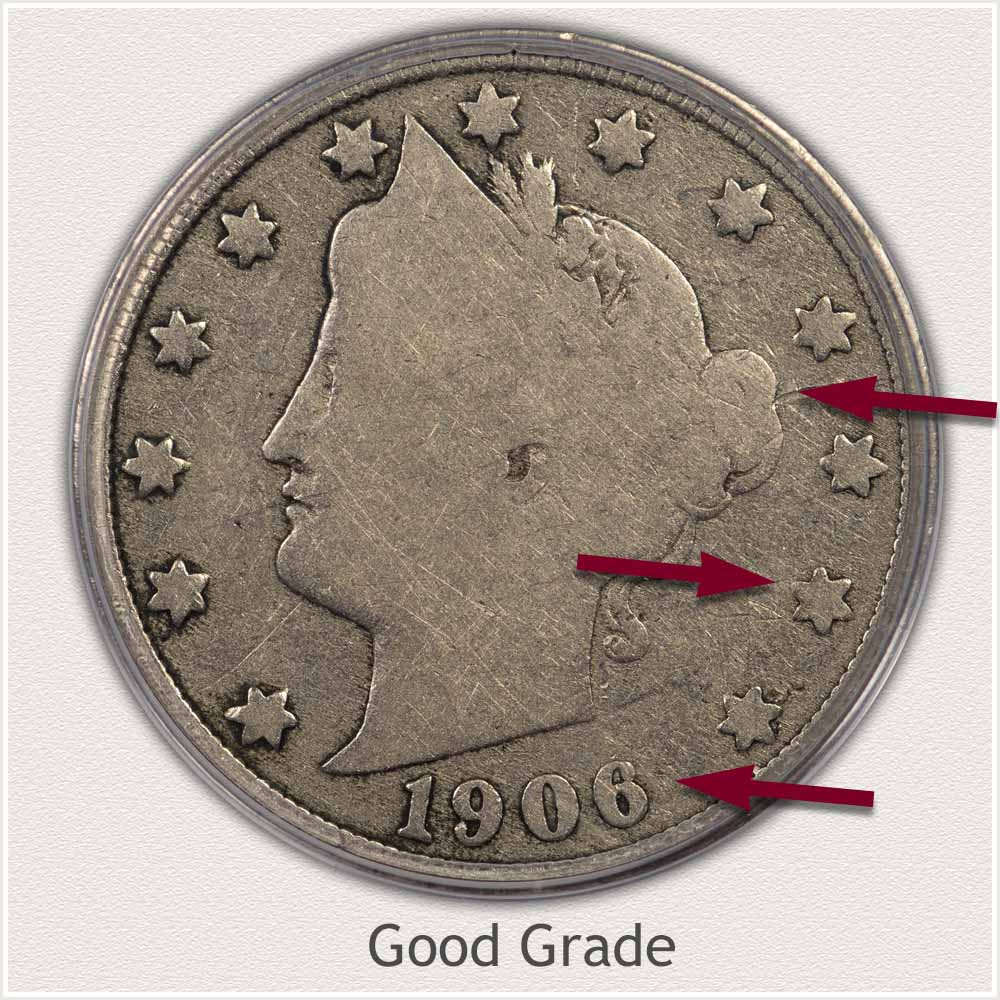
Good Grade: Because of extended use at the time, Good grade, heavily worn condition 1907 nickels are the majority of those remaining today. These are, however, of interest to a new collector. A favorable trait of the design is how well it retains a pleasing appearance even when heavily worn. Defining the grade is all major features are worn smooth, however, well outlined.
Beginning with Liberty and her portrait, inner details are worn smooth. The complete outline of the portrait does remain full and well raised above the field of the coin. Framing the strong outline of Liberty is a circle of complete stars. Thirteen stars, bold and separate of a raised inner rim, gives a completeness to the overall remaining details. Adding the presence of a strong date confirms the Good grade.
How to Video: Grading Liberty Nickels
Add experience and review the video featuring additional grading points. Descriptions highlight key elements to understanding an accurate grade of these old Liberty nickels.
Grading Liberty Nickels | How to Video and Descriptions
Step 3: | Special Qualities | Placing a Value on Low Condition Nickels
How Much is a Damaged Liberty Nickel Worth?
Damage to the surface and how much the coin is worth is often a matter of whether the coin is a rare date or a common date. Overall, any damage, large marks, or discoloration severely lowers value. How much lower is when rarity begins to play a role.
Determining the value of a damaged but routinely available coin, such as nickels dated 1900 to 1911, is typically given a base value of just a few cents above face value.
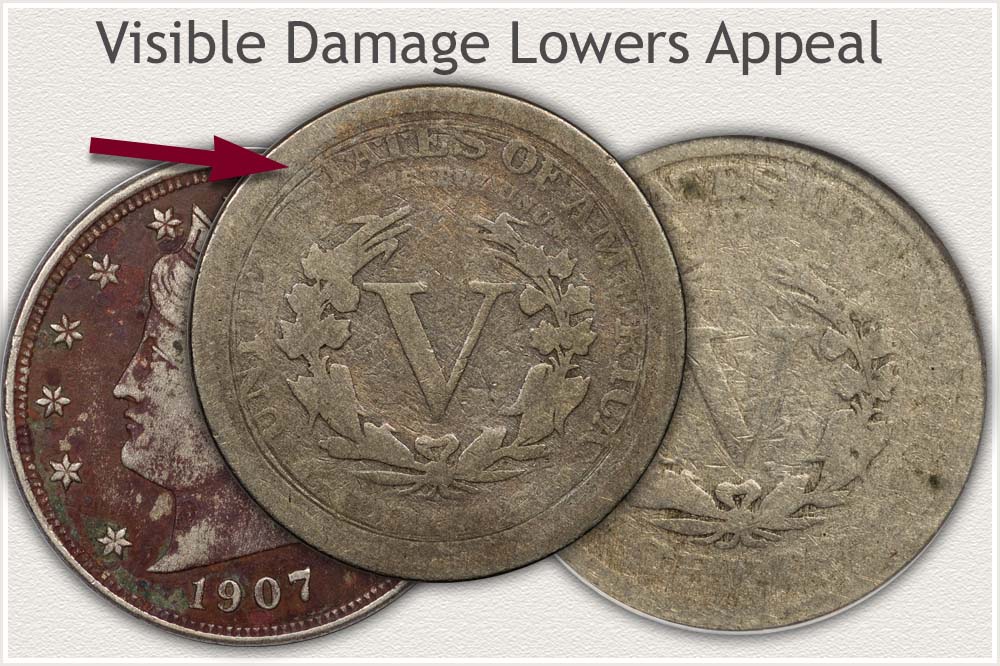 Damaged Liberty Nickels With Low Premiums and Appeal
Damaged Liberty Nickels With Low Premiums and Appeal
Liberty nickels from the early part of the twentieth century are an available coin. A 1907 nickel was minted in the multi-millions, a "common" date today to find in a box of old coins. Damaged examples are avoided by collectors, and discounted. They are simply too abundant.
The 1907 nickel imaged is discolored and shows a form of erosion damage caused by improper storage. The darkened surface is unnatural and uncollectible.
Large marks on the center nickel are very disruptive. These represent severe mishandling not associated with normal usage. Rim dents, scratches, and large marks draw attention. An otherwise nice coin except for the unwanted distractions. Coins displaying these types of damage are avoided by collectors and dealers.
At the right is an example of heavy wear removing the majority of design elements, leaving the surface almost blank. No features visible lowers the coin into the non-collectible category.
The problematic part of a value assessment are the "rare" dates and mints, a 1912-S nickel is a good example. A high value coin when wholesome. However, often pieces with "damage" are also avoided because of the difficulty of a dealer finding a buyer. Expect a very low value for these coins. Most collectors are willing to wait, seeking a nice quality example.
Eye appeal is the key issue with damaged coins. Nickel is a bright white-silver when first minted. Circulation wear removes the shine and luster, and the surface naturally becomes a soft light grey. Toning of circulated nickels is a tan or darker gray color.
Values take into consideration how far removed from natural a coin is altered. Marks disrupt the design, heavy wear removes features, and discoloration is unappealing. Minimum value is often the result when damage is visible on coins.
References
U.S. Mint. 1908 U.S. Mint Annual Report
https://nnp.wustl.edu/library/book/514124
U.S. Mint. Catalogue of Coins of the United States.
https://nnp.wustl.edu/library/book/554591
Coin Values | CoinStudy Articles
Date by Date
In Depth Liberty Nickel Values
1883 to 1912
The Value of V Nickels | A Series with a Wide Range in Rarity
Value chart of all dates and varieties of Liberty nickels list the various scarce and common dates and grades. 1885 followed by 1886 and 1912 are significant years of the series.
Popular Coin Series | Liberty Nickels
Demand and popularity are important to understanding market values. Ranking of major coin series shows nickels just after dimes in popularity.
Safe Coin Storage | Highlights and Recommendations
Protecting old nickels from humidity is a first consideration to maintaining their value. Review a few coin holders and storage methods for keeping coins protected long term. Safe handling is also provided by products specific to coins.
Print the Coin Values Worksheet
Record important data and comments for each coin. Compile descriptions and value while maintaining a written copy of the complete collection of your coins.
Selling Coins | A Defined Process
During the selling process key information is needed. Review the methods used by the hobbyist in the coin market. Determine an estimate of value and reference the listing of dealers to contact.
★Coin Values Discovery finds 1907 Nickel Value and...
An extensive listing of coin values, organized by series. Identify U.S. coinage, denominations, varieties, and how to determine condition. Proceed through a step-by-step method and place a value on a box of old coins.
